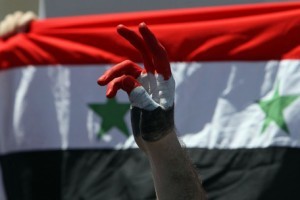Revolutionary pacifism under fire

Since the first day of the revolution, demonstrators’ chants have called for pacifism as a means to topple the regime, despite attempts by the head of the state and those around him to militarise the uprising.
A substantial section of people are aware that carrying arms will push the entire country into the throes of a civil war, which will give the current repressive regime an excuse to shed more blood. This is why Syrian revolutionaries have struggled to preserve the pacifist character of the revolution, despite all regime’s violations against civilians and the calls for militarisation by some of the parties involved in the revolution.
“Revolutionary pacifism is equivalent to a determination to change the abnormal regimes without destabilising the state, and without the violation of the first right in the human rights charter: the right to life,” said researcher Hassan Abbas. “The problem starts whenever violence exceeds its legal limits and takes a brutal and barbaric turn, at which point it will provoke a violent response on behalf of the people, which is justified by the right to life.
“Potential violence then becomes active violence which aims to deter the [initial violence carried out by the regime]; it is along this thin line that separates the refusal of violence in the aim to preserve, life and the exercise of violence to protect life that lies the controversy of the militarisation of the revolution,” he continued.
As the events of the revolution continue to unfold with a rising toll of killings and arrests carried out by the security forces and pro-regime shabiha thugs, the opposition has become divided into two camps: one calls for foreign intervention, even if military, while the other continues to uphold the pacifist character of the revolution, refusing to turn the country into a battlefield.
As a result of this pacifist trend, groups that are striving to preserve the unity of the revolution made intermittent calls for strikes and civil disobedience, considered the best option to bring down the regime and take the revolution to a new stage. In the view of pacifists, even though this option requires extra effort, it guarantees that the revolution will not deviate from its principles of non-violence and will show that people are capable of taking care of their own affairs in a civilised manner.
Many believe that the Syrian revolution is orphaned, left to meet its fate without any support.
“No one is supporting the Syrians in their revolution,” said poet Rasha Omar. “There has been collusion on the part of Arab officials, as well as regional and international [powers] in order to terminate this revolution. It seems that no one is willing to intervene to protect the Syrian people who stand exposed to one of the bloodiest and most terrorising regimes,” she added.
“Carrying arms will result in civil war because the regime is able to arm its supporters with modern weapons and will have the cover to commit more crimes because it would then be facing armed militants and not peaceful civilians,” she continued. “The second option, which is safer for the Syrian people in the long run, is choosing pacifism as a means of popular resistance, through peaceful demonstrations, which are taking place everywhere in Syria, in addition to promoting the concept of strikes and civil disobedience, which requires a rational civic discourse that could reach the business sector, or [intervention] by some of the clerics whose support for the revolution is trusted, and who can influence a large number of Damascenes.”
As a result of the numerous calls for strikes, the Syrian National Council issued a statement declaring the “Strike of Dignity” on December 16 last year. The results of this strike were clear in many cities and parts of the countryside, which are still committed to all of its stages, despite the tight security grip.
Damascus and Aleppo, however, continue to react extremely slowly to everything that has been going on, although the Syrian capital has been more responsive to the revolution than its northern sister, where the signs of the revolution in the past two months have been less palpable than they are in the rebellious cities.
“Civil disobedience will be a hard blow to the regime, because it will paralyse [it] and create a vertical crack in [its structure],” according to writer and activist Rima Fleihan, who added that the option of peaceful struggle still has not been fully exploited. “Strikes have been painful for the regime and have driven it into a state of state of hysteria, because they belied the claims of official media and proved that the revolution is expanding and making the regime economically powerless, which is an important factor in bringing it down.”
Now that the long-awaited Arab League observers are in Syria, the regime is stumbling as it tries to set the stage to prove the presence of “armed gangs” in order to justify its brutality as a form of defence of the people as well as self-defence. If the pacifist option is implemented in all of the Syrian cities and specifically in Damascus, it will be an arrow that pierces straight to the heart of the regime, without dragging the country into a fierce battle that could turn the whole country into ashes.
Civil disobedience requires essential conditions, according to lawyer Anwar al-Bunni, the first of which is the presence of a well-organized opposition which is geographically spread out and present across all productive sectors, and is able to carry out such a move without putting people’s basic life necessities at risk. The second condition, according to Bunni, is the presence of a large financial support for this in order to pay indemnities to anyone who could suffer economically as a result of civil disobedience, in addition to international support and the presence of a regime which is ready to consider relinquishing power once it discovers that it has lost its legitimacy.
“All of these conditions are not available in the Syrian case,” added Bunni. “The opposition is neither unified nor well-organised; at least part of it doesn’t have the ability to manage or mobilise such an activity.”
Bunni does not believe that such an action will be fully successful, at least not the first time round, but nonetheless, he thinks it is necessary to do it “in order to encourage those who are scared to participate in demonstrations to do something that could not get them killed, as well as exploiting all the peaceful options to topple the regime”. According to Bunni, the risk the pacifist option carries is that once it fails, it will lead to further demands for militarisation, which could then fulfill the desires of the regime and threaten the future of the entire Syrian society.
As the regime continues to shed Syrian blood on the one hand, and on the other the chants for homeland, peace and freedom attempt to maintain the purity of their revolution persist, the question of which route to follow remains unanswered.
Whether they decide to resort to the peaceful or military option, the revolutionaries should do whatever it takes to protect their land, families and loved ones, even if it meant risking their own lives as they walk towards freedom.
